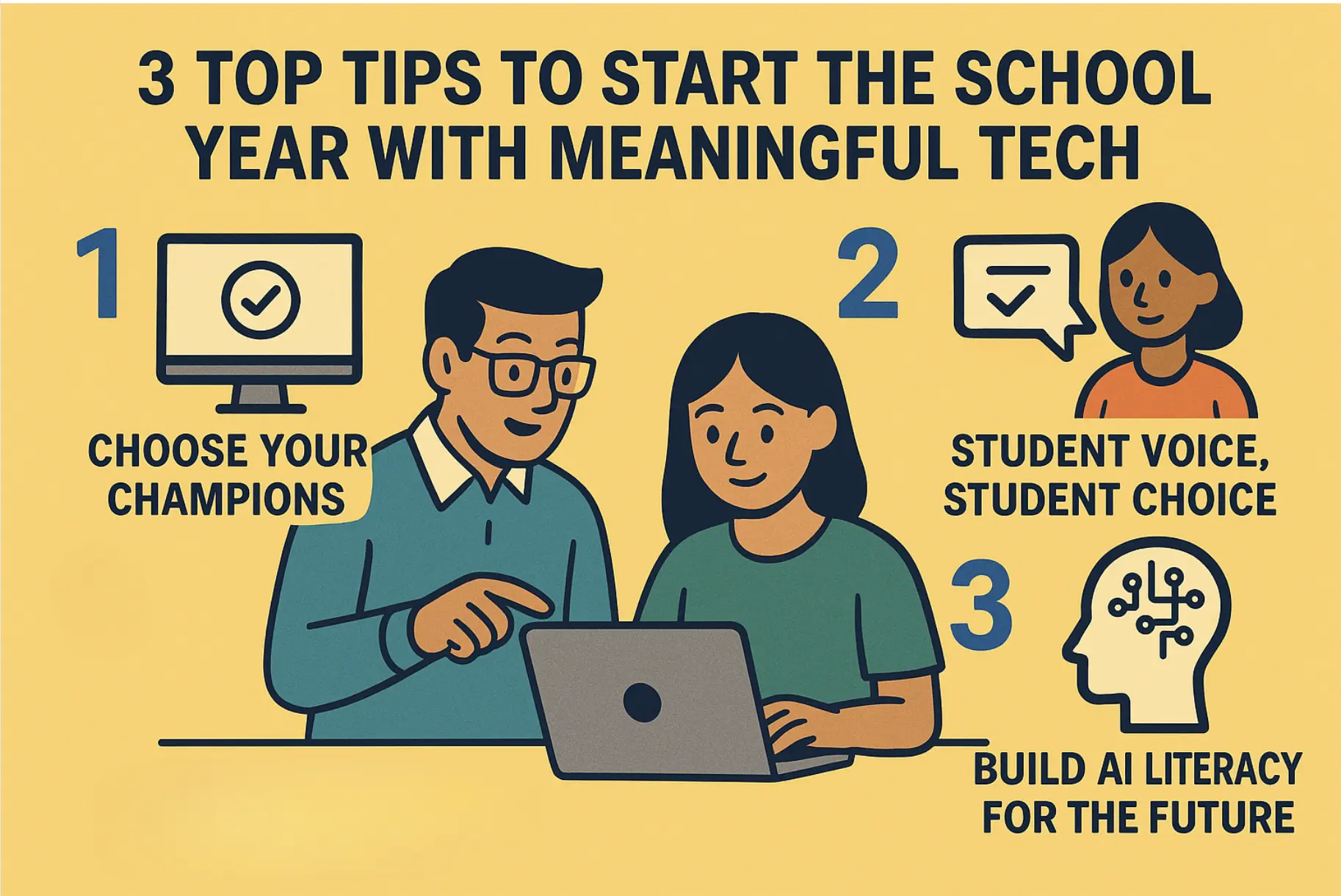3 Top Tips to Start the School Year with Meaningful Tech
As educators prepare for another school year, the promise and pressure of educational technology looms large. With countless apps, platforms, and digital tools vying for classroom attention, it’s easy to feel overwhelmed by the possibilities—or paralyzed by the choices. The key to meaningful tech integration isn’t about using more tools; it’s about using the right tools well.
Here are three essential strategies to help you start the school year with purposeful, impactful technology use.
Tip 1: Choose Your Champions—Quality Over Quantity
One pitfall educators may experience is tool overload. Instead of trying to master every different platform you see on social media or in your colleagues orbits, identify 2-3 core technologies that align with your learning objectives and commit to mastering them. Bonus points if you can leverage a tool that your school or district already supports. They may already have resources, coaches, or trainings on those tools.
When selecting your tech champions, ask yourself: Does this tool solve a real problem in my classroom? Does it enhance learning in ways that wouldn’t be possible without it? Can I see myself and my students becoming genuinely proficient with it over time?
Remember, students learn better when they can develop deep familiarity with tools rather than constantly adapting to new interfaces. A well-implemented Google Workspace, learning management system, or creative platform will always outperform a scattered collection of half-learned applications.
Tip 2: Student Voice, Student Choice
The most meaningful technology integration happens when students have agency in their learning tools. Rather than mandating specific apps or platforms for every task, create opportunities for students to explore and advocate for the technologies that resonate with their learning styles and interests.
Consider starting the year with a “tech showcase” where students can demonstrate tools they already use for creativity, organization, or learning. Build choice into your assignments—let students choose between creating a video, podcast, infographic, or interactive presentation to demonstrate their understanding.
When students feel ownership over their digital tools, engagement naturally follows. They become collaborators in the learning process rather than passive recipients of predetermined tech experiences. This approach also prepares them for real-world scenarios where they’ll need to evaluate and select appropriate tools for different tasks.
Tip 3: Build AI Literacy for the Future
Artificial intelligence isn’t just coming to education—it’s already here. Rather than avoiding or fearing AI tools, this school year presents an opportunity to help students develop critical AI literacy skills that will serve them throughout their academic and professional lives.
Begin by becoming comfortable with AI tools yourself. Experiment with using AI for lesson planning, creating discussion questions, or generating multiple perspectives on complex topics. Once you’ve developed confidence with AI as an educator, you can better guide students in meaningful integration.
Make the most of well-crafted prompt stems when introducing AI to students. Try prompts like:
- “Create a Socratic dialogue between [historical figure] and [modern expert] about [current issue] that reveals three different perspectives” or
- “Generate a scenario where students must evaluate conflicting AI-generated arguments about [topic] and identify potential biases or gaps in reasoning” or
- “Design a problem-solving activity where AI provides initial research, but students must synthesize, critique, and build upon that information to reach their own conclusions.”
Most importantly, focus on developing skills that complement AI: critical thinking, creativity, emotional intelligence, and complex problem-solving. When students understand both AI’s capabilities and limitations, they’re better positioned to use these tools thoughtfully and effectively.
Moving Forward with Purpose
Meaningful technology integration isn’t about keeping up with the latest trends—it’s about thoughtfully selecting, implementing, and reflecting on the tools that truly enhance learning. By focusing your efforts, amplifying student voice, and preparing learners for an AI-enhanced future, you’ll create a classroom environment where technology serves learning rather than distracting from it.
As you embark on this school year, remember that the most powerful educational technology is still an engaged teacher working with curious students. Everything else is just a tool to help make that magic happen.
Written by Tiffani Brown, Program Specialist at CUE. This post has AI-supported content that was human-reviewed.

